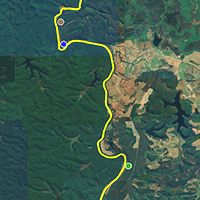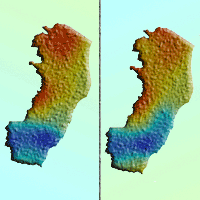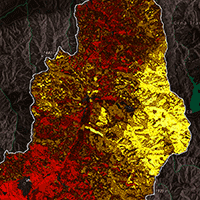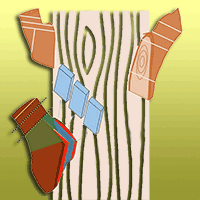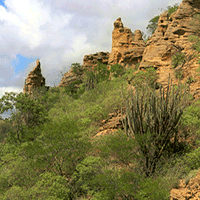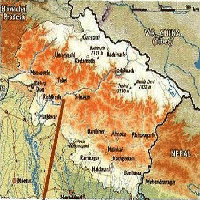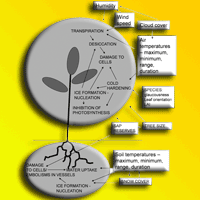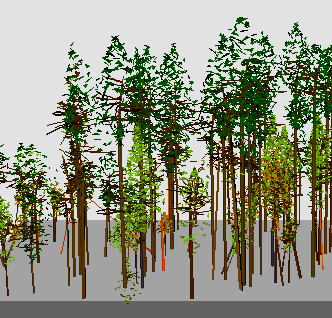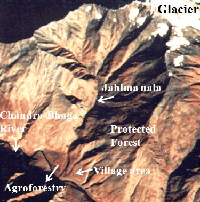
Diversity, distribution and vegetation assessment in the Jahlmanal watershed in cold desert of the Lahaul valley, north-western Himalaya, India
YS Rawat (1) , SCR Vishvakarma (1), SS Oinam (2), JC Kuniyal (2)
iForest - Biogeosciences and Forestry, Volume 3, Issue 3, Pages 65-71 (2010)
doi: https://doi.org/10.3832/ifor0532-003
Published: May 17, 2010 - Copyright © 2010 SISEF
Research Articles
Abstract
Relict vegetation in the Jahlmanal watershed is sparsely and scantily distributed on forest land. Farmers maintain tree species (Salix spp., Populus spp., Hippophae rhamnoides) on the boundaries of terraced agriculture fields to meet the fodder and fuel wood requirements. Juniperus macropoda was found in relict forest patches in sparse and stunted conditions. The density of Salix fragilis was 3340 trees ha-1 under agroforestry and 5520 trees ha-1 under forestry. The density of J. macropoda was 4200 tree ha-1 in natural forest followed by 700 tree ha-1 in agroforestry and 160 tree ha-1 in managed forestry systems. The agroforesty system of the watershed consists of 30% trees, 35% small trees and 35% shrubs species. Shrubs contributed the highest density with 59.1% of the total, followed by density of trees (29.5%) and small trees (11.3%). Trees contributed highest basal area in all the three systems, i.e., agroforestry, forestry and forest. The relict forest patches are subjected to deforestation due to anthropogenic pressure, hence in-situ and ex-situ conservation are required. Efforts are needed for plantation of ecologically suitable multipurpose tree species with indigenous species in the watershed. Technological interventions are also required to improve the quality and resistance against drought and climate change.
Keywords
Vegetation analysis, Agroforestry, Forestry, Forest, Watershed, Lahaul valley, Cold desert, Indian Himalaya
Authors’ Info
Authors’ address
SCR Vishvakarma
G.B. Pant Institute of Himalayan Environment and Development, Kosi-Katarmal, Almora 263 643 Uttarakhand (India)
JC Kuniyal
G.B. Pant Institute of Himalayan Environment and Development, Himachal Unit, Mohal-Kullu 175 126 Himachal Pradesh (India)
Corresponding author
Paper Info
Citation
Rawat YS, Vishvakarma SCR, Oinam SS, Kuniyal JC (2010). Diversity, distribution and vegetation assessment in the Jahlmanal watershed in cold desert of the Lahaul valley, north-western Himalaya, India. iForest 3: 65-71. - doi: 10.3832/ifor0532-003
Paper history
Received: Dec 24, 2009
Accepted: Apr 21, 2010
First online: May 17, 2010
Publication Date: May 17, 2010
Publication Time: 0.87 months
Copyright Information
© SISEF - The Italian Society of Silviculture and Forest Ecology 2010
Open Access
This article is distributed under the terms of the Creative Commons Attribution-Non Commercial 4.0 International (https://creativecommons.org/licenses/by-nc/4.0/), which permits unrestricted use, distribution, and reproduction in any medium, provided you give appropriate credit to the original author(s) and the source, provide a link to the Creative Commons license, and indicate if changes were made.
Web Metrics
Breakdown by View Type
Article Usage
Total Article Views: 63839
(from publication date up to now)
Breakdown by View Type
HTML Page Views: 53793
Abstract Page Views: 3626
PDF Downloads: 5202
Citation/Reference Downloads: 20
XML Downloads: 1198
Web Metrics
Days since publication: 5681
Overall contacts: 63839
Avg. contacts per week: 78.66
Citation Metrics
Article Citations
Article citations are based on data periodically collected from the Clarivate Web of Science web site
(last update: Mar 2025)
Total number of cites (since 2010): 6
Average cites per year: 0.38
Publication Metrics
by Dimensions ©
Articles citing this article
List of the papers citing this article based on CrossRef Cited-by.
References
Action plan on cold desert: an integrated approach for sustainable development. Regional center, NAEB, UHF, Solan, pp. 1-40.
Gscholar
Annual report. G.B. Plant Institute of Himalayan Environment and Development, Kosi-Katarmal, Almora (India), pp. 55-56.
Gscholar
Alpine flora in west Himalayan mountain of India: a curious view. Himalayan Research and Development 8: 10-13.
Gscholar
Flora of Lahual-Spiti. A cold desert in north west Himalaya. Bishen Singh, Mahendra Pal Singh, Dehradun, India, pp. 10-15.
Gscholar
The vegetation of Wisconsin: an ordination of plant communities. University of Wisconsin Press, Madison, Winconsin, USA.
Gscholar
Plant ecology workbook. Laboratory field production in <i>Andropogon gerardi</i>. Ecology 31: 488-489.
Gscholar
The interrelations of certain analytic and synthetic phytosociological characters. Ecology 46: 84-89.
Gscholar
Ladhak: an update on natural resources. In: “High altitudes of the Himalaya - Biogeography, ecology and conservation” (Pangety YPS, Rawal RS eds). pp. 102-114.
Gscholar
The Himalayan district of Koloo, Lahaul and Spiti. Vivek Publishing House (reprint 1972), Delhi, India, pp. 74.
Gscholar
Quantitative and dynamic plant ecology. ELBS and Edward Arnold Publishers Ltd. London, pp. 308.
Gscholar
A distance method for constructing forest profile diagram and obtaining structural data. Tropical Ecology 4: 89-94.
Gscholar
Kuth (<i>Saussurea lappa</i>) cultivation in the cold desert environment of the Lahaul valley, northwestern Himalaya, India: arising threats and need to revive socio-economic. Biodiversity and Conservation 14 (5): 1035-1045.
CrossRef | Gscholar
Seabuckthorn (<i>Hippophae L</i>). A promising plant for land-restoration in the cold desert Himalayas. In: “Proceedings of International Workshop on Seabuckthorn” (Singh V, Khosla PK eds). Feb. 18-21 2002, New Delhi, India, pp. 1-6.
Gscholar
Tree species diversity in the eastern deciduous forest with particular references to north central Florida. American Naturalist 10: 173-187.
Gscholar
Multipurpose tree species with potential for introduction in agroforestry system in Himalayan mountains. In: “Agroforestry system for degraded lands” (Singh P, Pathak PS, Roze MM eds). Oxford & IBH publishing co-pvt-Ltd, New Delhi, India, pp. 269-278.
Gscholar
The measurement of diversity in different types of biological collections. Journal Theoretical Biology 13: 131-144.
Gscholar
Agroforestry for sustainable development of rural people ecosystem of central Himalaya. Proceedings of the “IUFRO-DNAES international meeting on resource inventory techniques to support agroforestry and environment activities” (Kohali RK, Arya KS eds). Dyanand National Academy of Environmental Science, DAV. Collage. Chandigarh (India) Oct 1-3 1996, pp. 301-305.
Gscholar
<i>Saussurea costus</i> (Falc.) Lipsch: a promising medicinal crop under cold desert agro-ecosystem in north-western Himalaya. Indian Journal of Forestry 27 (3): 297-303.
Gscholar
Willow (<i>Salix fragilis</i> Linn.): a multipurpose tree species under pest attack in the cold desert of Lahaul valley, north-western Himalaya, India. Ambio 35 (1): 43-48.
Gscholar
Vegetational analysis, socio-economic and cultural aspects of <i>Salix</i> sp. in cold desert environment of the Lahaul valley, north-western Himalaya (HP). Ph.D. Thesis, Garhwal University, Srinagar Garhwal, UK-India, pp. xiii+270.
Gscholar
Seabuckthorn: a multipurpose plant species for fragile mountains. International centre for integrated mountain development (ICIMOD), Occasional Paper No. 20, Kathmandu, Nepal, pp.1-62.
Gscholar
The mathematical theory of communication. University Illinois Press, Urbana, USA, pp.17.
Gscholar
Changing traditional land use patterns in the Great Himalayas: a case study of Lahaul Valley. Journal of Environmental Systems 25 (2): 195-211.
Gscholar
Statistical methods. Oxford and IBH publishing Co., New Delhi, India.
Gscholar
Ethnobotany of cold desert tribes of Lahaul-Spiti (NW, Himalaya). Deep Publication, New Delhi, India, pp. 228.
Gscholar
Analysis of woody vegetation in a mixed Oak forest of Kumaon Himalaya. Proc. Indian Sci. Acad. 332-345.
Gscholar
Indigenous agroforestry system of north western Himalaya. Research for mountain development: some initiative and accomplishment. Gyanodaya Prakashan, Nainital, Uttarakhand, India, pp. 99-118.
Gscholar
Irrigation (Kuhls): a community management system in cold desert of the Lahaul valley, northwestern Himalaya, India. In: Proceedings of the “Third international seminar on farmer managed irrigation systems and governance alternatives” (Pradhan P, Gautam U eds). Kathmandu (Nepal), Sep 9-10 2004, pp. 425-444.
Gscholar
Impact of anthropogenic activities on Bio-resource in cold desert of Lahaul valley, north-western Himalaya. Submitted to the Ministry of Environment & Forests, New Delhi, India. F. No. 10/35/99-CS/BR of 10<sup>th</sup> April 2000, pp. 190.
Gscholar
Communities and ecosystem (2<sup>nd</sup> edn). Macmillan publishing Co. New York, pp. 385.
Gscholar


